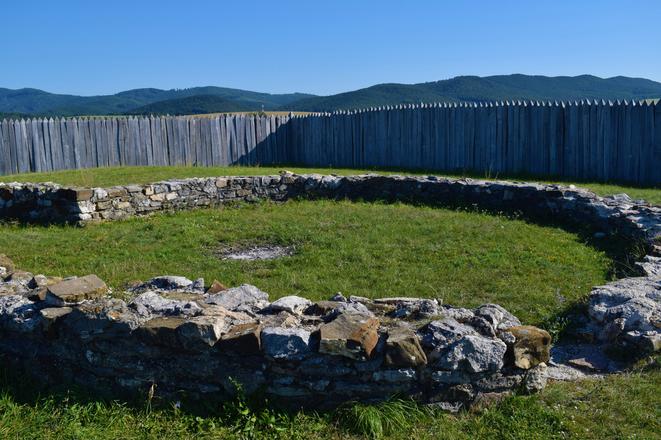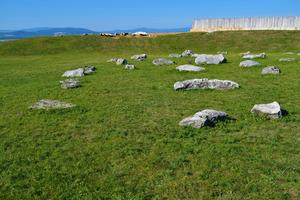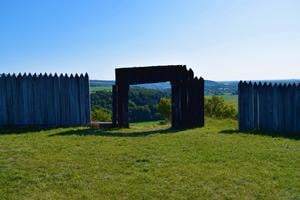Before the ancient god, Rod, the absolute, primordial god of the universe and of all other gods, had created all things, he created Lada, the great goddess of the earth, harmony and joy, embodying youth, spring, beauty, fertility, and love. Thanks to her, he managed to crack a golden egg and from the cold wave of chaos to create the Universe.
After Rod created the Universe, he asked his three sons to reign. The oldest was Svarog, the most powerful, clever, and skillful smith. Goddess Lada admired him and fell in love. They married and together they developed the Universe. One day Lada asked Mokosh, the Mother goddess personifying the fertile earth, associated with female works and harvest, for clay to create the beings who will colonize the earth. And Lada created everything living on the earth, Svarog breathed the soul in. And Rod with one kiss gave them mind and consciousness. Rod, Svarog and Lada created people from earth, words, soul, and consciousness.
And therefore after death the body returns to goddess Mokosh, the soul accompanied by Veles, the "Black God", returns to the underworld, and the consciousness finds his way to Rod.
Such stories were told to shorten the long journey. They came from the valley of Dniester, Pripiať and Dnieper. From the cradle of their tribe. The Slavs. When they came, they chased away the Celts and the Germanic tribes. And settled down in forests, the asylum and source of living. But also full of shadows and dangers. They settled down near rivers, which they admired and loved. And above all, the Slavic Gods and Goddesses reigned. With Rod, Svarog and Lada at the head.
Where the Slavs settled down
The isolated mountain range shades the main road from Bratislava to Žilina. It is 48 km long, 15 to 25 km wide, and has a composite geological structure. It is rich in mineral water sources, but without longer rivers. Here meet thermophilic and mountain flora and diverse fauna. Považský Inovec mountain range.
And here the Slavs settled down. Here they built the first settlements in the shadow of sacred oak trees, to which they prayed for rain. Here lived in waters and woods Little Goddesses and Nymphs. At nights they sang, played music and clapped their hands. They were so beautiful that they bewitched young men and could lure them to their deaths by drawing them into deep water.
Until the Slavs built the safe and great settlement surrounded by seven rounded hills and promoted it to the center of its first empire, the Great Moravia. The first state formation of the Slavs.
Považský Inovec was interweaven with many communications, which connected several regions. And the most important road, was the Amber Road, an ancient trade route for the transfer of amber from coastal areas of the North Sea and the Baltic Sea to the Mediterranean Sea.
Walking through the Slavic territory
Today the green marked hiking path will lead you from the Nitrianska Blatnica village, passing the Blatnický Jurko chapel, the oldest chapel in Slovakia, to the 748 m high Marhát mountain.
This name! Marhát! What is its origin?
Maybe it comes from the Great Moravia, and in Moravianit it is from the "Marharii" and "Merehani" tribes. Or it is Celtic or Germanic "marko" or "marha" and means horse. Or it is Hungarian "marha" and means cattle! Or maybe it is Old German "markat, marchat, marchot", and means market.
There was an important Slavic settlement Bojná Valy under the Marhát mountain beginning in the 9th century. With a toll-gate and market place for cattle trade.
While walking in forest you will sure find yourself in front of the Bojná Valy. And if you continue, you will reach the following Slavic settlement, Kostolec, Ducové.
Or the Čertova pec cave! And there, before your eyes, a story begins. The old Slavs dressed in leather and fur sit around the fire and gossip. Probably about the goddess Lada and her husband, god Svarog, who reign in marvelous Iria and live in wonderful palace, surrounded by a park with sacred lime and birch trees.
The Slavs lived in harmony with woods and forests, in which they were unconquerable. Their settlements were built strategically in forests, in moors, on river islands. But they were also hospitable and generous.
They knew democracy. Their assembly was called "VECE" which means things or sentence, reminiscent of ancient Athens.
The name "Slovania" or "Sloveni" (the Slavs) has the word "SLOVO" meaning word in its base. And the word has the easiness of wind and the power of thunder.
VaGa Agencyis an incoming company concentrating on active, adventure, bike and sport tours in Slovakia, in the unique, authentic and safe country, far away from mass tourism; offer undiscovered and amazing places, tailored-made solutions and very professional individual guiding. For more information please visit: vaga.agency.


 Ducové (source: VaGa)
Ducové (source: VaGa)


